Digital Media & Culture: Analysis of Platforms, Impact & Communication
VerifiedAdded on 2022/10/12
|8
|2015
|479
Essay
AI Summary
This essay delves into the evolving landscape of digital media and culture, examining the significant role of digital platforms in shaping contemporary society and communication. It addresses the shift from traditional media consumption to active engagement, highlighting how digital tools have democratized media production and integrated global cultures. The essay explores the strengths and weaknesses of the digital revolution, emphasizing its impact on cultural transmission, identity formation, and the emergence of new communication forms. It also discusses the challenges of analyzing digital culture due to its rapid evolution and the interdisciplinary approaches required to understand its complexities. Ultimately, the essay argues for a comprehensive study of digital culture that considers both technological advancements and the resulting changes in human practices and cultural products.
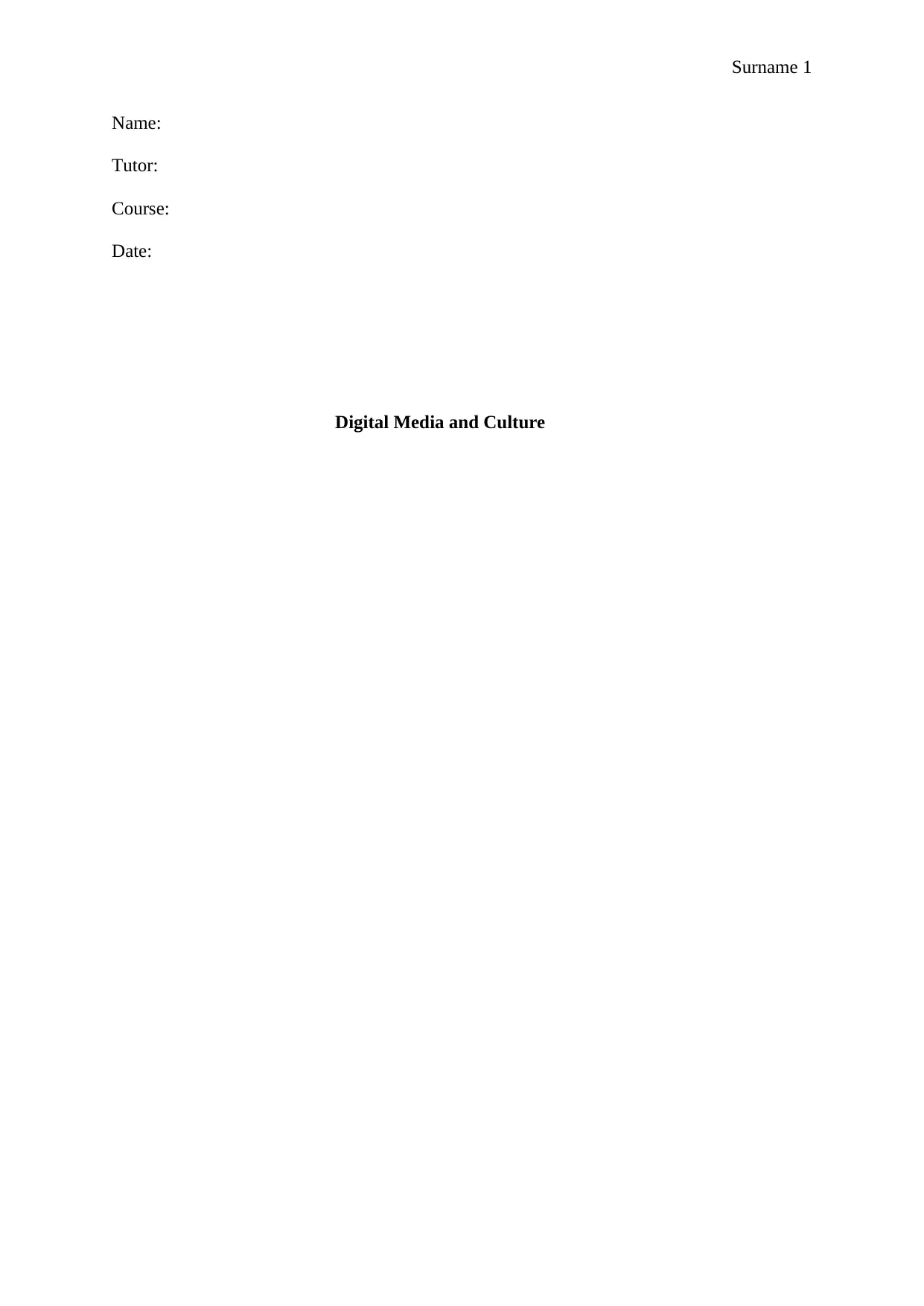
Surname 1
Name:
Tutor:
Course:
Date:
Digital Media and Culture
Name:
Tutor:
Course:
Date:
Digital Media and Culture
Paraphrase This Document
Need a fresh take? Get an instant paraphrase of this document with our AI Paraphraser

Surname 2
Introduction
The communication and digital culture offers an excellent pathway and opportunity to
engage people in contemporary issues of culture, society and media in the digital era. This
pathway examines the relationships between technology, media and everyday life and reflect
the digital cultures of everyday practices. The debates are centered on: the impact of cultures
and role of communications of media in the digital age; technologies that are in the public eye
such as social media, technology and big data; research methods used in digital media
communications. The current stage of international relations is characterized by increasing
interdependence and interconnection of participants in the world community (Shields, 88).
The process of changing the world order, creating a new reality through information
technology, expanding global social, cultural, political and economic ties, the general
communication sphere, has been called globalization.
Thesis statement
The millennial media and digital media platforms reduce the barriers between casual
media engagers and professional media producers. What makes the digital media different is
its availability and speed. Much of these characteristics is due to the digital tools. The new
media or what is contemporary referred to as the digital media is interactive, networked,
hyper textual, simulated and virtual. Digital media has opened the access to communication
in the world and integrated cultures (Martin, 23). It’s not a secret to anyone that in modern
studies, the promotion of new media among guardians of a high culture is perceived with
deep skepticism or even panic. Although it is known: even in ancient times, Plato severely
criticized written texts, which later became an unshakable constant in the entire history of the
development of mankind. Recent innovations in the media today provide new, very
Introduction
The communication and digital culture offers an excellent pathway and opportunity to
engage people in contemporary issues of culture, society and media in the digital era. This
pathway examines the relationships between technology, media and everyday life and reflect
the digital cultures of everyday practices. The debates are centered on: the impact of cultures
and role of communications of media in the digital age; technologies that are in the public eye
such as social media, technology and big data; research methods used in digital media
communications. The current stage of international relations is characterized by increasing
interdependence and interconnection of participants in the world community (Shields, 88).
The process of changing the world order, creating a new reality through information
technology, expanding global social, cultural, political and economic ties, the general
communication sphere, has been called globalization.
Thesis statement
The millennial media and digital media platforms reduce the barriers between casual
media engagers and professional media producers. What makes the digital media different is
its availability and speed. Much of these characteristics is due to the digital tools. The new
media or what is contemporary referred to as the digital media is interactive, networked,
hyper textual, simulated and virtual. Digital media has opened the access to communication
in the world and integrated cultures (Martin, 23). It’s not a secret to anyone that in modern
studies, the promotion of new media among guardians of a high culture is perceived with
deep skepticism or even panic. Although it is known: even in ancient times, Plato severely
criticized written texts, which later became an unshakable constant in the entire history of the
development of mankind. Recent innovations in the media today provide new, very
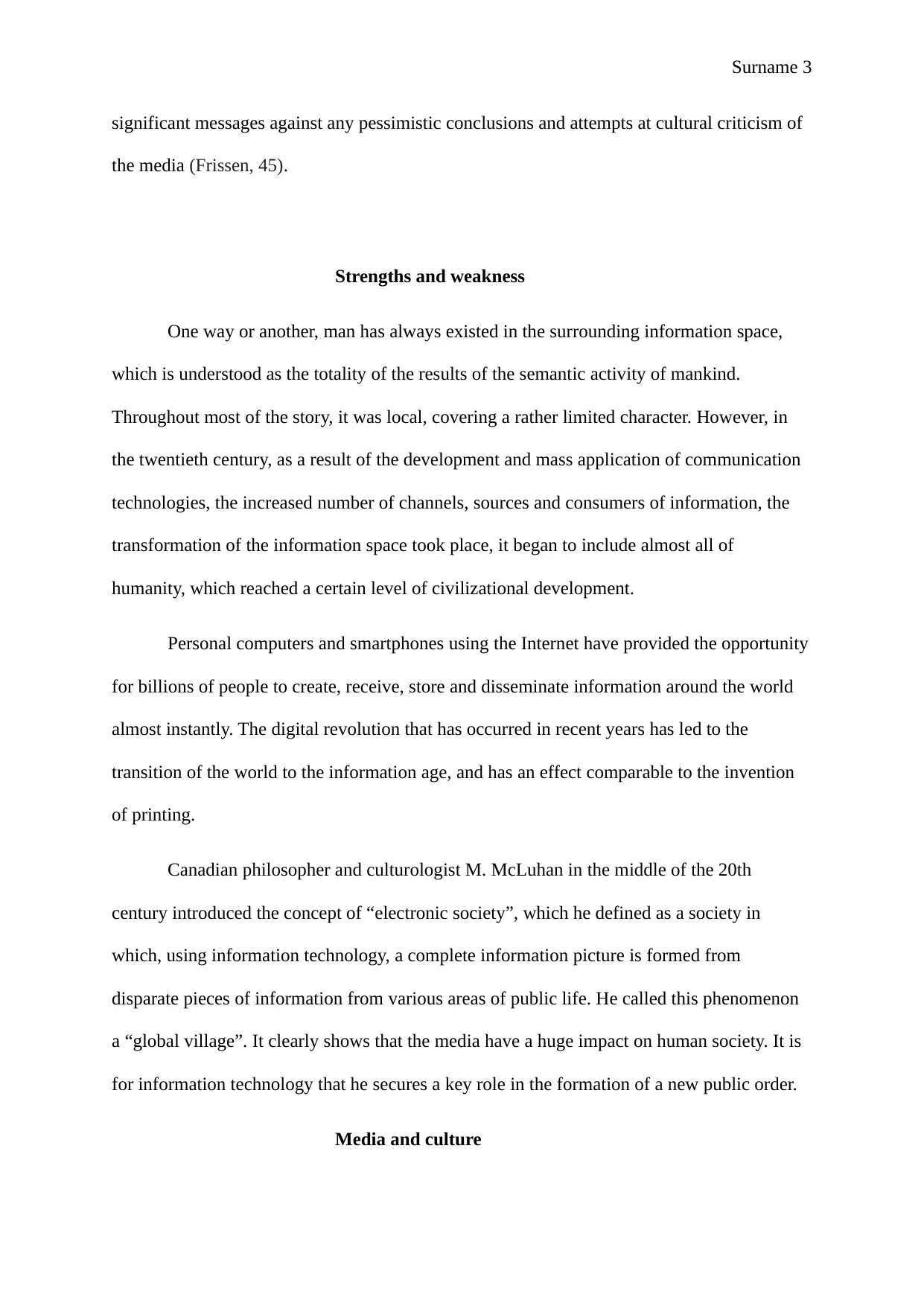
Surname 3
significant messages against any pessimistic conclusions and attempts at cultural criticism of
the media (Frissen, 45).
Strengths and weakness
One way or another, man has always existed in the surrounding information space,
which is understood as the totality of the results of the semantic activity of mankind.
Throughout most of the story, it was local, covering a rather limited character. However, in
the twentieth century, as a result of the development and mass application of communication
technologies, the increased number of channels, sources and consumers of information, the
transformation of the information space took place, it began to include almost all of
humanity, which reached a certain level of civilizational development.
Personal computers and smartphones using the Internet have provided the opportunity
for billions of people to create, receive, store and disseminate information around the world
almost instantly. The digital revolution that has occurred in recent years has led to the
transition of the world to the information age, and has an effect comparable to the invention
of printing.
Canadian philosopher and culturologist M. McLuhan in the middle of the 20th
century introduced the concept of “electronic society”, which he defined as a society in
which, using information technology, a complete information picture is formed from
disparate pieces of information from various areas of public life. He called this phenomenon
a “global village”. It clearly shows that the media have a huge impact on human society. It is
for information technology that he secures a key role in the formation of a new public order.
Media and culture
significant messages against any pessimistic conclusions and attempts at cultural criticism of
the media (Frissen, 45).
Strengths and weakness
One way or another, man has always existed in the surrounding information space,
which is understood as the totality of the results of the semantic activity of mankind.
Throughout most of the story, it was local, covering a rather limited character. However, in
the twentieth century, as a result of the development and mass application of communication
technologies, the increased number of channels, sources and consumers of information, the
transformation of the information space took place, it began to include almost all of
humanity, which reached a certain level of civilizational development.
Personal computers and smartphones using the Internet have provided the opportunity
for billions of people to create, receive, store and disseminate information around the world
almost instantly. The digital revolution that has occurred in recent years has led to the
transition of the world to the information age, and has an effect comparable to the invention
of printing.
Canadian philosopher and culturologist M. McLuhan in the middle of the 20th
century introduced the concept of “electronic society”, which he defined as a society in
which, using information technology, a complete information picture is formed from
disparate pieces of information from various areas of public life. He called this phenomenon
a “global village”. It clearly shows that the media have a huge impact on human society. It is
for information technology that he secures a key role in the formation of a new public order.
Media and culture
⊘ This is a preview!⊘
Do you want full access?
Subscribe today to unlock all pages.

Trusted by 1+ million students worldwide
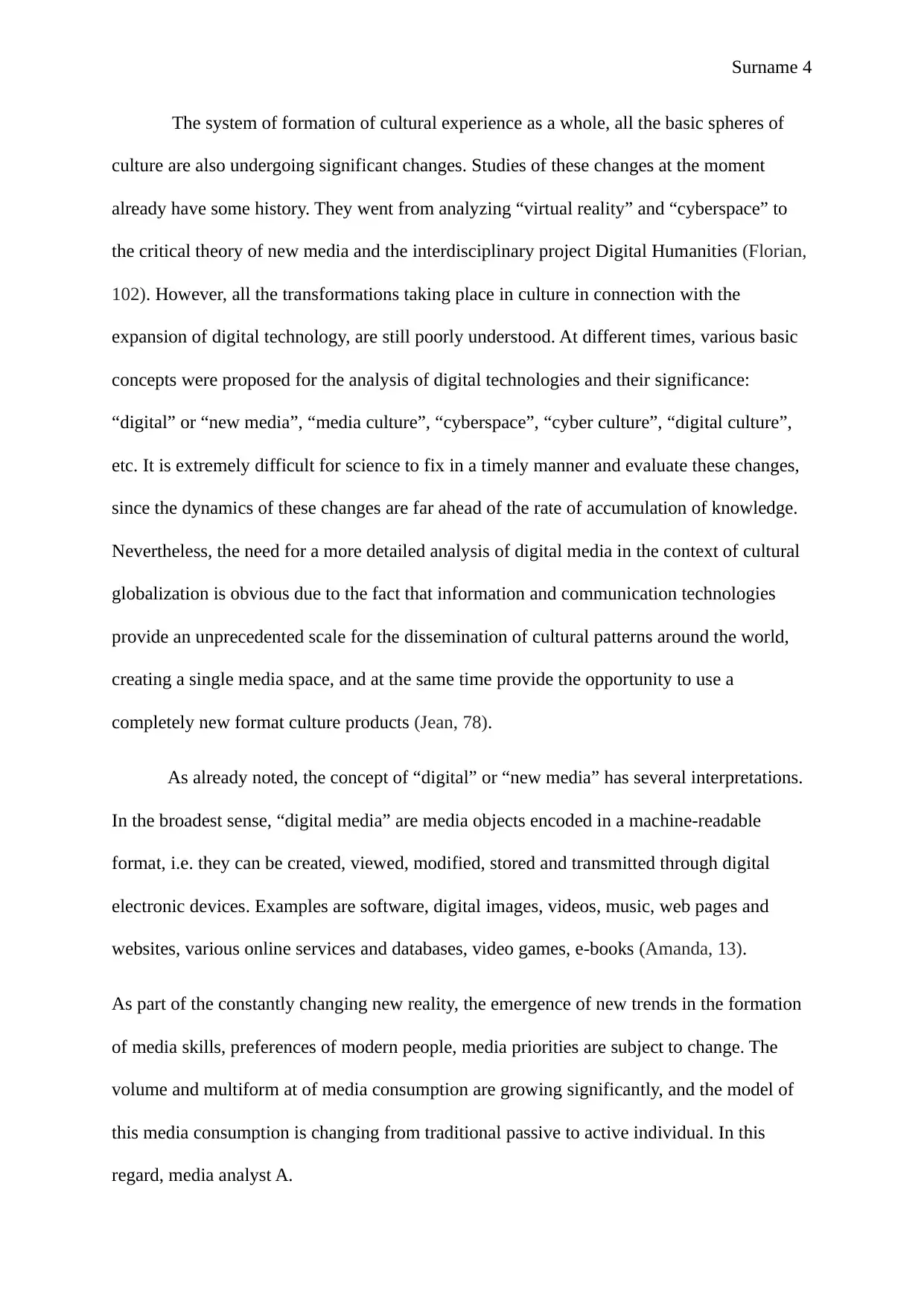
Surname 4
The system of formation of cultural experience as a whole, all the basic spheres of
culture are also undergoing significant changes. Studies of these changes at the moment
already have some history. They went from analyzing “virtual reality” and “cyberspace” to
the critical theory of new media and the interdisciplinary project Digital Humanities (Florian,
102). However, all the transformations taking place in culture in connection with the
expansion of digital technology, are still poorly understood. At different times, various basic
concepts were proposed for the analysis of digital technologies and their significance:
“digital” or “new media”, “media culture”, “cyberspace”, “cyber culture”, “digital culture”,
etc. It is extremely difficult for science to fix in a timely manner and evaluate these changes,
since the dynamics of these changes are far ahead of the rate of accumulation of knowledge.
Nevertheless, the need for a more detailed analysis of digital media in the context of cultural
globalization is obvious due to the fact that information and communication technologies
provide an unprecedented scale for the dissemination of cultural patterns around the world,
creating a single media space, and at the same time provide the opportunity to use a
completely new format culture products (Jean, 78).
As already noted, the concept of “digital” or “new media” has several interpretations.
In the broadest sense, “digital media” are media objects encoded in a machine-readable
format, i.e. they can be created, viewed, modified, stored and transmitted through digital
electronic devices. Examples are software, digital images, videos, music, web pages and
websites, various online services and databases, video games, e-books (Amanda, 13).
As part of the constantly changing new reality, the emergence of new trends in the formation
of media skills, preferences of modern people, media priorities are subject to change. The
volume and multiform at of media consumption are growing significantly, and the model of
this media consumption is changing from traditional passive to active individual. In this
regard, media analyst A.
The system of formation of cultural experience as a whole, all the basic spheres of
culture are also undergoing significant changes. Studies of these changes at the moment
already have some history. They went from analyzing “virtual reality” and “cyberspace” to
the critical theory of new media and the interdisciplinary project Digital Humanities (Florian,
102). However, all the transformations taking place in culture in connection with the
expansion of digital technology, are still poorly understood. At different times, various basic
concepts were proposed for the analysis of digital technologies and their significance:
“digital” or “new media”, “media culture”, “cyberspace”, “cyber culture”, “digital culture”,
etc. It is extremely difficult for science to fix in a timely manner and evaluate these changes,
since the dynamics of these changes are far ahead of the rate of accumulation of knowledge.
Nevertheless, the need for a more detailed analysis of digital media in the context of cultural
globalization is obvious due to the fact that information and communication technologies
provide an unprecedented scale for the dissemination of cultural patterns around the world,
creating a single media space, and at the same time provide the opportunity to use a
completely new format culture products (Jean, 78).
As already noted, the concept of “digital” or “new media” has several interpretations.
In the broadest sense, “digital media” are media objects encoded in a machine-readable
format, i.e. they can be created, viewed, modified, stored and transmitted through digital
electronic devices. Examples are software, digital images, videos, music, web pages and
websites, various online services and databases, video games, e-books (Amanda, 13).
As part of the constantly changing new reality, the emergence of new trends in the formation
of media skills, preferences of modern people, media priorities are subject to change. The
volume and multiform at of media consumption are growing significantly, and the model of
this media consumption is changing from traditional passive to active individual. In this
regard, media analyst A.
Paraphrase This Document
Need a fresh take? Get an instant paraphrase of this document with our AI Paraphraser
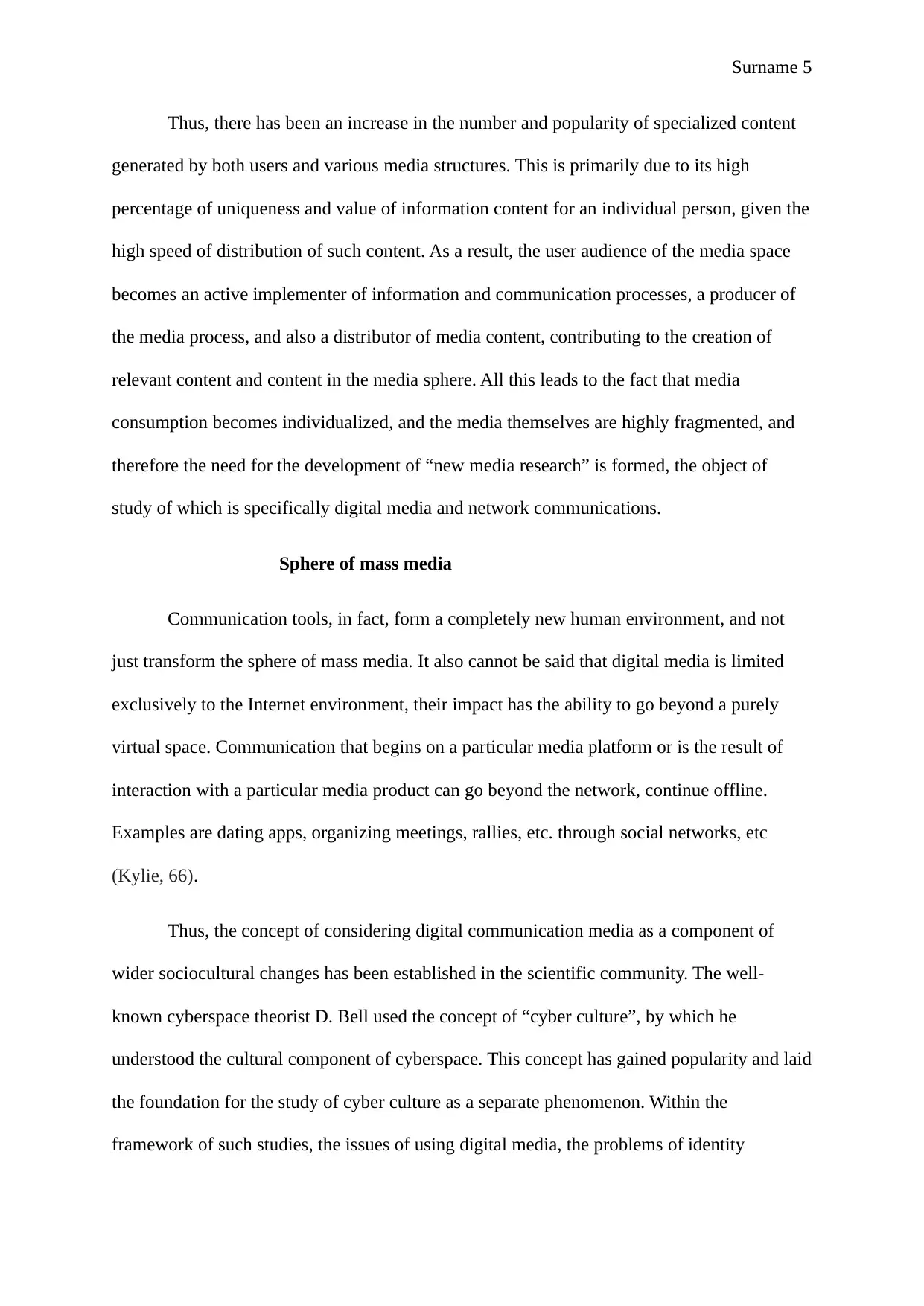
Surname 5
Thus, there has been an increase in the number and popularity of specialized content
generated by both users and various media structures. This is primarily due to its high
percentage of uniqueness and value of information content for an individual person, given the
high speed of distribution of such content. As a result, the user audience of the media space
becomes an active implementer of information and communication processes, a producer of
the media process, and also a distributor of media content, contributing to the creation of
relevant content and content in the media sphere. All this leads to the fact that media
consumption becomes individualized, and the media themselves are highly fragmented, and
therefore the need for the development of “new media research” is formed, the object of
study of which is specifically digital media and network communications.
Sphere of mass media
Communication tools, in fact, form a completely new human environment, and not
just transform the sphere of mass media. It also cannot be said that digital media is limited
exclusively to the Internet environment, their impact has the ability to go beyond a purely
virtual space. Communication that begins on a particular media platform or is the result of
interaction with a particular media product can go beyond the network, continue offline.
Examples are dating apps, organizing meetings, rallies, etc. through social networks, etc
(Kylie, 66).
Thus, the concept of considering digital communication media as a component of
wider sociocultural changes has been established in the scientific community. The well-
known cyberspace theorist D. Bell used the concept of “cyber culture”, by which he
understood the cultural component of cyberspace. This concept has gained popularity and laid
the foundation for the study of cyber culture as a separate phenomenon. Within the
framework of such studies, the issues of using digital media, the problems of identity
Thus, there has been an increase in the number and popularity of specialized content
generated by both users and various media structures. This is primarily due to its high
percentage of uniqueness and value of information content for an individual person, given the
high speed of distribution of such content. As a result, the user audience of the media space
becomes an active implementer of information and communication processes, a producer of
the media process, and also a distributor of media content, contributing to the creation of
relevant content and content in the media sphere. All this leads to the fact that media
consumption becomes individualized, and the media themselves are highly fragmented, and
therefore the need for the development of “new media research” is formed, the object of
study of which is specifically digital media and network communications.
Sphere of mass media
Communication tools, in fact, form a completely new human environment, and not
just transform the sphere of mass media. It also cannot be said that digital media is limited
exclusively to the Internet environment, their impact has the ability to go beyond a purely
virtual space. Communication that begins on a particular media platform or is the result of
interaction with a particular media product can go beyond the network, continue offline.
Examples are dating apps, organizing meetings, rallies, etc. through social networks, etc
(Kylie, 66).
Thus, the concept of considering digital communication media as a component of
wider sociocultural changes has been established in the scientific community. The well-
known cyberspace theorist D. Bell used the concept of “cyber culture”, by which he
understood the cultural component of cyberspace. This concept has gained popularity and laid
the foundation for the study of cyber culture as a separate phenomenon. Within the
framework of such studies, the issues of using digital media, the problems of identity
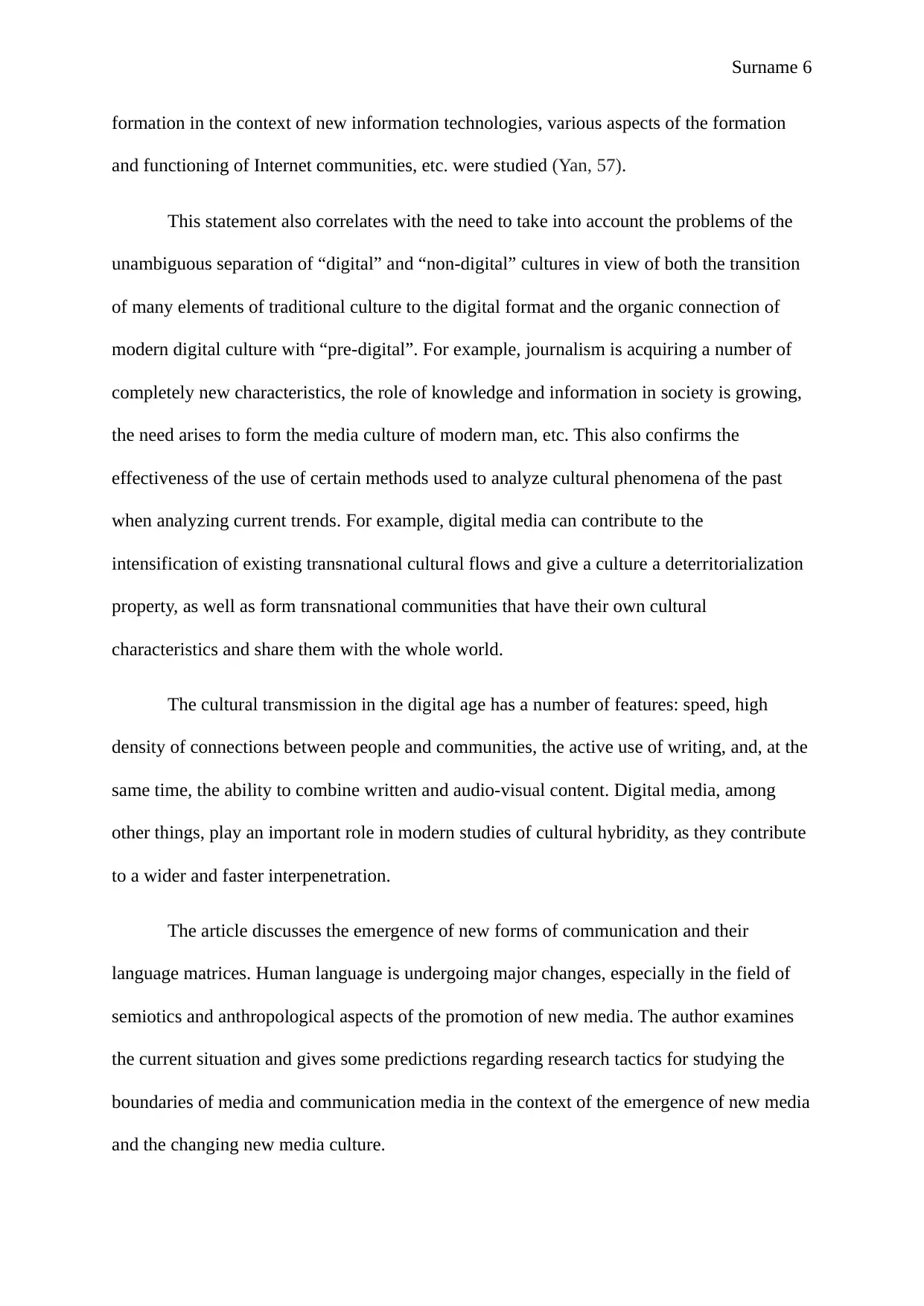
Surname 6
formation in the context of new information technologies, various aspects of the formation
and functioning of Internet communities, etc. were studied (Yan, 57).
This statement also correlates with the need to take into account the problems of the
unambiguous separation of “digital” and “non-digital” cultures in view of both the transition
of many elements of traditional culture to the digital format and the organic connection of
modern digital culture with “pre-digital”. For example, journalism is acquiring a number of
completely new characteristics, the role of knowledge and information in society is growing,
the need arises to form the media culture of modern man, etc. This also confirms the
effectiveness of the use of certain methods used to analyze cultural phenomena of the past
when analyzing current trends. For example, digital media can contribute to the
intensification of existing transnational cultural flows and give a culture a deterritorialization
property, as well as form transnational communities that have their own cultural
characteristics and share them with the whole world.
The cultural transmission in the digital age has a number of features: speed, high
density of connections between people and communities, the active use of writing, and, at the
same time, the ability to combine written and audio-visual content. Digital media, among
other things, play an important role in modern studies of cultural hybridity, as they contribute
to a wider and faster interpenetration.
The article discusses the emergence of new forms of communication and their
language matrices. Human language is undergoing major changes, especially in the field of
semiotics and anthropological aspects of the promotion of new media. The author examines
the current situation and gives some predictions regarding research tactics for studying the
boundaries of media and communication media in the context of the emergence of new media
and the changing new media culture.
formation in the context of new information technologies, various aspects of the formation
and functioning of Internet communities, etc. were studied (Yan, 57).
This statement also correlates with the need to take into account the problems of the
unambiguous separation of “digital” and “non-digital” cultures in view of both the transition
of many elements of traditional culture to the digital format and the organic connection of
modern digital culture with “pre-digital”. For example, journalism is acquiring a number of
completely new characteristics, the role of knowledge and information in society is growing,
the need arises to form the media culture of modern man, etc. This also confirms the
effectiveness of the use of certain methods used to analyze cultural phenomena of the past
when analyzing current trends. For example, digital media can contribute to the
intensification of existing transnational cultural flows and give a culture a deterritorialization
property, as well as form transnational communities that have their own cultural
characteristics and share them with the whole world.
The cultural transmission in the digital age has a number of features: speed, high
density of connections between people and communities, the active use of writing, and, at the
same time, the ability to combine written and audio-visual content. Digital media, among
other things, play an important role in modern studies of cultural hybridity, as they contribute
to a wider and faster interpenetration.
The article discusses the emergence of new forms of communication and their
language matrices. Human language is undergoing major changes, especially in the field of
semiotics and anthropological aspects of the promotion of new media. The author examines
the current situation and gives some predictions regarding research tactics for studying the
boundaries of media and communication media in the context of the emergence of new media
and the changing new media culture.
⊘ This is a preview!⊘
Do you want full access?
Subscribe today to unlock all pages.

Trusted by 1+ million students worldwide
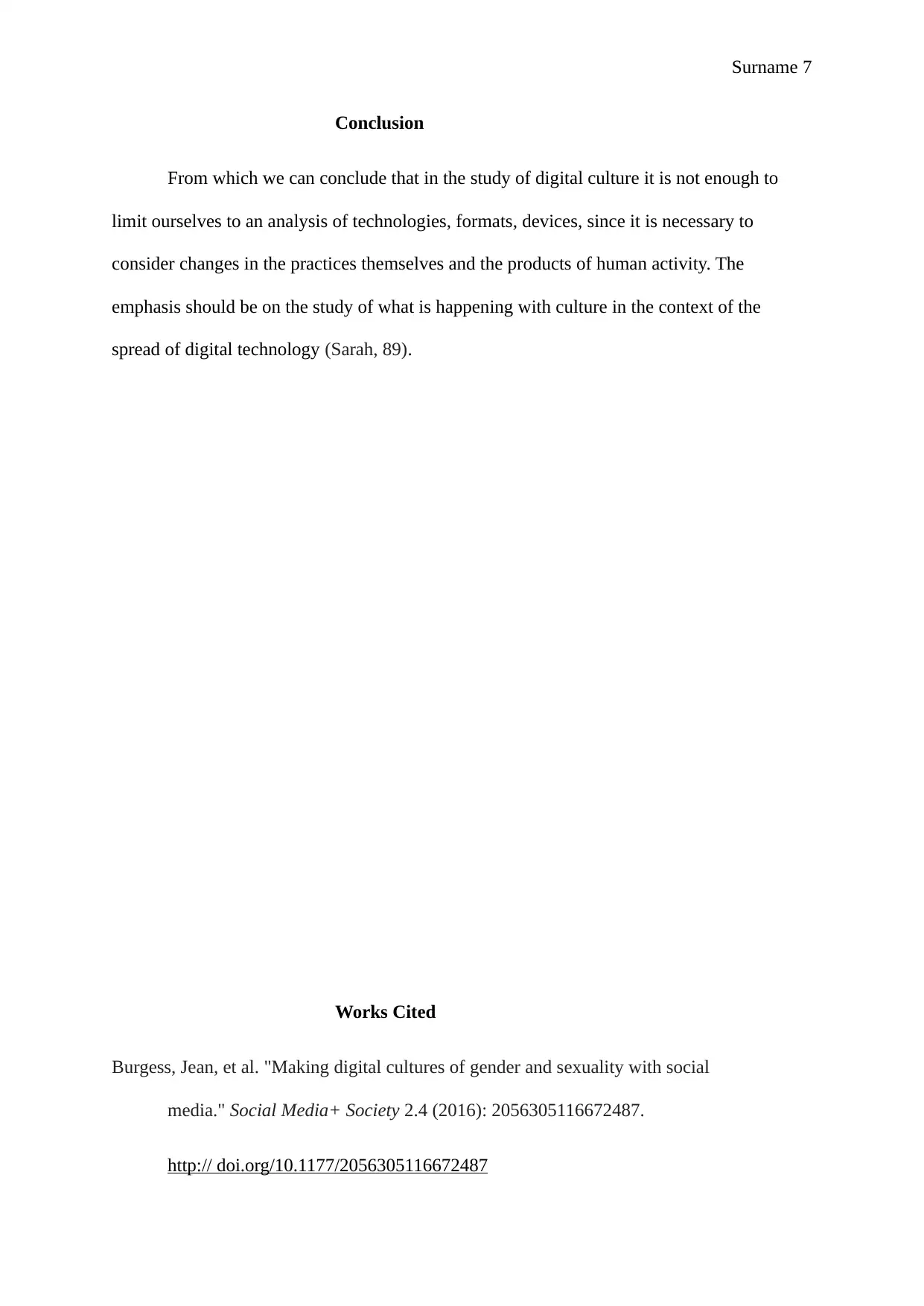
Surname 7
Conclusion
From which we can conclude that in the study of digital culture it is not enough to
limit ourselves to an analysis of technologies, formats, devices, since it is necessary to
consider changes in the practices themselves and the products of human activity. The
emphasis should be on the study of what is happening with culture in the context of the
spread of digital technology (Sarah, 89).
Works Cited
Burgess, Jean, et al. "Making digital cultures of gender and sexuality with social
media." Social Media+ Society 2.4 (2016): 2056305116672487.
http:// doi.org/10.1177/2056305116672487
Conclusion
From which we can conclude that in the study of digital culture it is not enough to
limit ourselves to an analysis of technologies, formats, devices, since it is necessary to
consider changes in the practices themselves and the products of human activity. The
emphasis should be on the study of what is happening with culture in the context of the
spread of digital technology (Sarah, 89).
Works Cited
Burgess, Jean, et al. "Making digital cultures of gender and sexuality with social
media." Social Media+ Society 2.4 (2016): 2056305116672487.
http:// doi.org/10.1177/2056305116672487
Paraphrase This Document
Need a fresh take? Get an instant paraphrase of this document with our AI Paraphraser
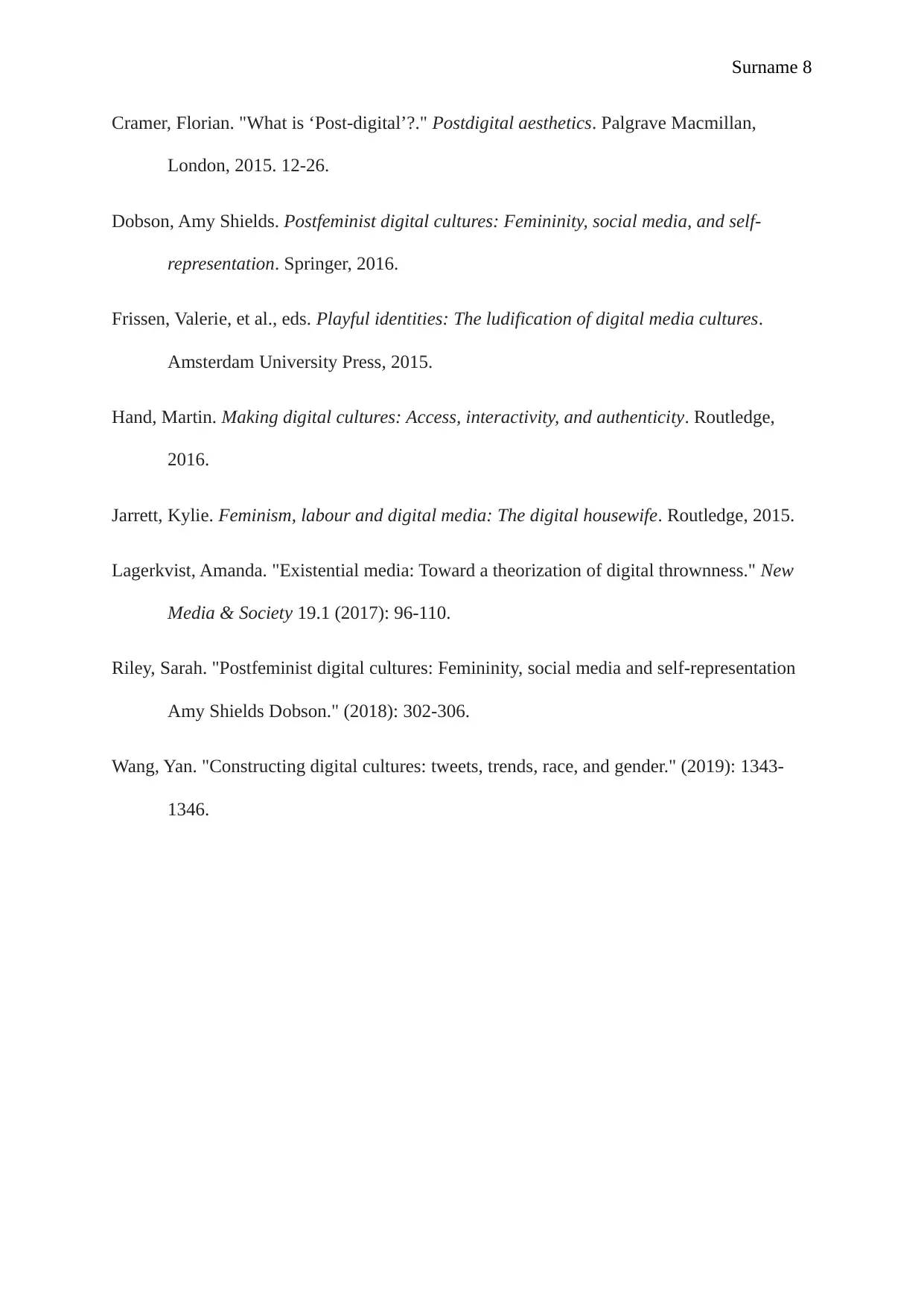
Surname 8
Cramer, Florian. "What is ‘Post-digital’?." Postdigital aesthetics. Palgrave Macmillan,
London, 2015. 12-26.
Dobson, Amy Shields. Postfeminist digital cultures: Femininity, social media, and self-
representation. Springer, 2016.
Frissen, Valerie, et al., eds. Playful identities: The ludification of digital media cultures.
Amsterdam University Press, 2015.
Hand, Martin. Making digital cultures: Access, interactivity, and authenticity. Routledge,
2016.
Jarrett, Kylie. Feminism, labour and digital media: The digital housewife. Routledge, 2015.
Lagerkvist, Amanda. "Existential media: Toward a theorization of digital thrownness." New
Media & Society 19.1 (2017): 96-110.
Riley, Sarah. "Postfeminist digital cultures: Femininity, social media and self-representation
Amy Shields Dobson." (2018): 302-306.
Wang, Yan. "Constructing digital cultures: tweets, trends, race, and gender." (2019): 1343-
1346.
Cramer, Florian. "What is ‘Post-digital’?." Postdigital aesthetics. Palgrave Macmillan,
London, 2015. 12-26.
Dobson, Amy Shields. Postfeminist digital cultures: Femininity, social media, and self-
representation. Springer, 2016.
Frissen, Valerie, et al., eds. Playful identities: The ludification of digital media cultures.
Amsterdam University Press, 2015.
Hand, Martin. Making digital cultures: Access, interactivity, and authenticity. Routledge,
2016.
Jarrett, Kylie. Feminism, labour and digital media: The digital housewife. Routledge, 2015.
Lagerkvist, Amanda. "Existential media: Toward a theorization of digital thrownness." New
Media & Society 19.1 (2017): 96-110.
Riley, Sarah. "Postfeminist digital cultures: Femininity, social media and self-representation
Amy Shields Dobson." (2018): 302-306.
Wang, Yan. "Constructing digital cultures: tweets, trends, race, and gender." (2019): 1343-
1346.
1 out of 8
Related Documents
Your All-in-One AI-Powered Toolkit for Academic Success.
+13062052269
info@desklib.com
Available 24*7 on WhatsApp / Email
![[object Object]](/_next/static/media/star-bottom.7253800d.svg)
Unlock your academic potential
Copyright © 2020–2025 A2Z Services. All Rights Reserved. Developed and managed by ZUCOL.





